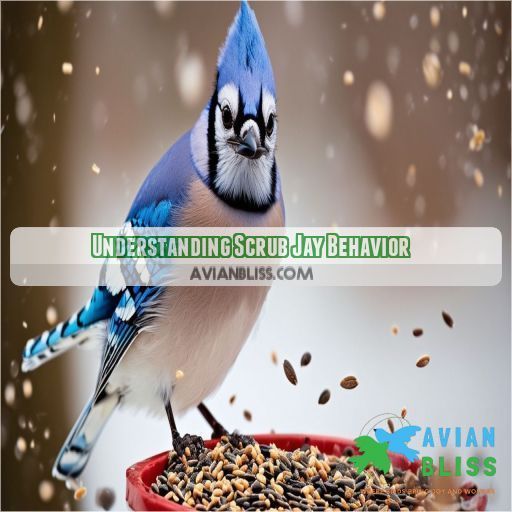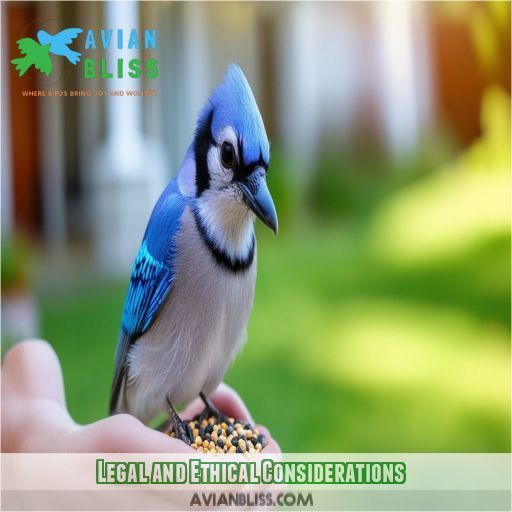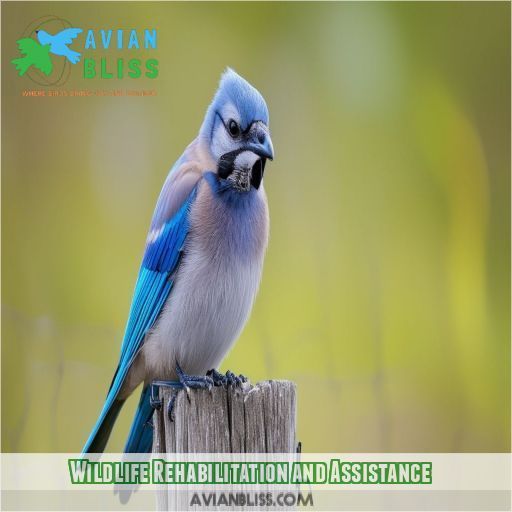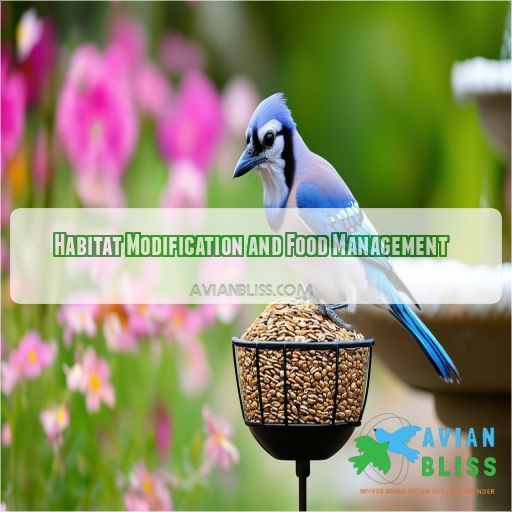This site is supported by our readers. We may earn a commission, at no cost to you, if you purchase through links.
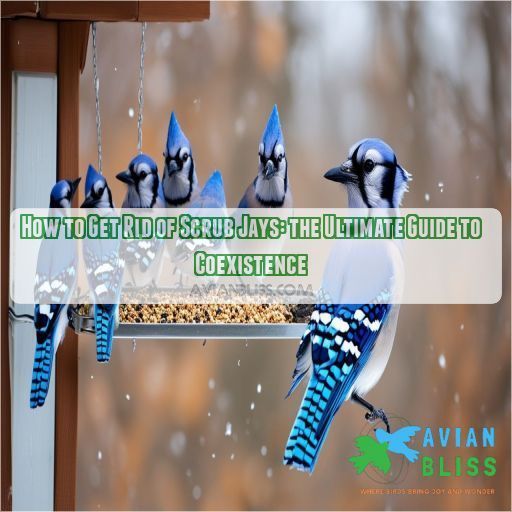
First off, it’s important to know that these guys aren’t too scared of us humans. So, waving your hands or poking their nests won’t do much. But, here’s a fun fact: scrub jays are terrified of birds of prey. So, if you place a fake raptor statue (think owls, hawks, or eagles) near their nest, you might just scare them off. You can also try covering your windows with opaque window clings to stop them from pecking at their reflection, which is a common behavior caused by birds mistaking their reflection for rivals. to reduce reflections.
Want more tips? Keep reading to discover how to outsmart these pesky birds and reclaim your space.
Table Of Contents
Key Takeaways
- Outsmart those feathered tricksters with visual deterrents like fake raptors or shiny objects. It’s like playing a game of bird chess – stay one move ahead!
- Create a "VIP lounge" for other birds by setting up secluded feeding areas. Let the scrub jays party elsewhere while the songbirds dine in peace.
- Get creative with your garden design. A bird-friendly oasis with diverse plants and water features might just be the ticket to a more harmonious backyard ecosystem.
- Remember, these blue bandits are protected by law, so stick to non-lethal methods. Think of it as a neighborly negotiation rather than an all-out war.
Understanding Scrub Jay Behavior
If you’re dealing with scrub jays in your yard or garden, understanding their behavior is key to finding a solution. These intelligent birds can be territorial and aggressive toward other birds, which can impact your feeding areas.
Aggressive Behavior Towards Other Birds
Are you tired of those pesky scrub jays hogging all the birdseed and chasing away the cute little songbirds? Well, you’re not alone! These bold birds can be a real headache when it comes to sharing your yard with other feathered friends. Let’s get into understanding their behavior and finding some peace.
Scrub jays are notoriously territorial and will staunchly defend their favorite feeding spots, sometimes acting like bully birds and chasing away smaller species. This dominance hierarchy is especially noticeable during nesting season when they’re protecting their young. It’s like they’ve got a ‘no vacancy’ sign up, and any other bird that tries to move in gets the boot!
Impact on Feeding Areas
If you’re dealing with scrub jays, you know they can be a handful at feeders. These bold birds have a knack for dominating the buffet, leaving other birds hungry. So, what’s the deal? Well, these jays are just doing what comes naturally – they’re competitive eaters with a taste for sunflower seeds, peanuts, and corn. It’s a game of survival of the fittest, and they’re out for that #1 spot.
Legal and Ethical Considerations
Before you take action, it’s important to understand the legal and ethical considerations involved in managing scrub jays. You need to be clued up on any regulations and permits that might apply, and also think about the best ways to approach wildlife management without causing harm.
Regulations and Permits
Before you do anything, it’s important to know the rules.
These birds are protected by wildlife laws, and you might need permits to do anything about them.
Even though they can be a pain, remember they’re part of nature and deserve respect.
Always try to find ways to live with them that are both good for the birds and legal.
Ethical Approaches to Wildlife Management
As a nature enthusiast, you might wrestle with managing wildlife in your yard, especially scrub jays. These birds are clever, but their feeder dominance is frustrating. So, how do you balance conservation and control? Here are some ethical tips:
- Understand Limits: Resources are finite. Managing scrub jay numbers is about keeping things sustainable for all species.
- Target Family Groups: Scrub jays live in families. Tailor your strategies to these groups for more effective results and harmony among the birds.
- Bird-Friendly Practices: Scrub jays are part of a diverse ecosystem. Embrace bird-friendly practices that foster a healthy environment for all species, not just scrub jays.
Non-lethal Deterrent Tactics
If you’re grappling with how to gently shoo away those pesky scrub jays without causing them harm, you’re in the right place. In this section, we’ll explore some clever, non-lethal ways to deter these birds from your space.
Visual and Auditory Deterrents
You can use a variety of visual and auditory tactics to deter scrub jays without causing them any harm. These clever birds can outsmart simple deterrents, so it’s important to keep things fresh and mix things up.
Startle those jays with shiny Mylar ribbons, whirligigs, and even foil pie plates. Add some movement to these visual scares by combining them with rotating noisemakers and wind chimes. But remember, these birds are smart, and they’ll catch on eventually, so switch things up every now and then to keep them on their toes!
Physical Barriers and Netting
If you’re dealing with scrub jays in your yard or garden, you might be wondering how to keep ’em from causing a ruckus and protect your precious plants. Well, my friend, it’s time to get physical (barriers, that is).
Netting and fencing are your secret weapons here. Go for 1/4- to 1/2-inch mesh netting or fencing to give those birds the old heave-ho. It’s like giving your plants their own bouncer—only the cool kids (aka pollinators) get in.
But here’s the deal: you gotta make sure that netting is positioned high and wide. Why? So those pesky jays can’t just perch on the edges and snack on your fruits through the netting. That’d be like letting a mouse into your cheese shop and then wondering why there are teeth marks in all the cheddar.
Wildlife Rehabilitation and Assistance
Sometimes, despite your best efforts, you might encounter injured or orphaned scrub jays. Knowing what to do in these situations is really important for their well-being and yours. This section will guide you on when and how to contact wildlife agencies for assistance and provide tips on rescuing these birds if you find them in distress.
Contacting Wildlife Agencies
If you’re unsure about regulations or need expert advice, contact your local wildlife agencies.
These agencies can provide guidance on ethical and legal practices for managing wildlife.
In Florida, for example, you can reach out to the Florida Fish and Wildlife Conservation Commission, the Florida Forest Service, or state parks for assistance.
Rescuing Injured or Orphaned Scrub Jays
Sometimes, you might come across injured or orphaned scrub jays that need a helping hand.
If you spot a nestling bird that seems to be alone, it’s best to observe from a distance for a while. The parents might be out hunting for food, and your presence could deter them from returning.
If the bird appears injured or is in immediate danger, you can step in and offer assistance.
Contact local wildlife agencies or rehabilitation centers specializing in bird care. They’ll provide guidance on next steps and ethical scrub jay care.
Habitat Modification and Food Management
If you’re struggling with scrub jays taking over your feeders or causing a ruckus in your yard, it’s time to get crafty with habitat modification and food management. In this section, we’ll explore ways to create some distance between you and these pesky birds while still maintaining a healthy ecosystem.
Secluded Feeding Areas
Creating secluded feeding areas is an effective way to manage scrub jay interactions and minimize their impact on your habitat. Here are some strategies to try:
- Set up secluded feeders in quieter areas of your yard or garden, away from the hustle and bustle of other bird feeders. This will attract scrub jays looking for a peaceful dining experience.
- Offer a variety of food sources that scrub jays love, such as seeds, nuts, and fruits. By providing an abundant food source away from other feeders, you’ll keep them coming back to their special spot.
- Consider feeder placement carefully. Place feeders at varying distances from cover, such as trees or bushes, to give scrub jays a sense of security while they eat.
- Understand the habitat impact. By creating these secluded feeding areas, you can help reduce competition and aggression between scrub jays and other bird species, promoting a harmonious environment for all.
Alternative Feeding Solutions
Now that you’ve created some distance between the scrub jays and your desired feeding spots, it’s time to offer these intelligent birds some alternative food sources. Remember, these birds are omnivores and will eat just about anything, so let’s explore some options to redirect their dining habits.
| Food Type | Examples |
|---|---|
| Seeds | Sunflower, Safflower, Millet, Cracked Corn |
| Nuts | Pecans, Walnuts, Almonds, Peanuts |
| Fruits | Berries, Apples, Grapes, Melons |
| Insects | Mealworms, Crickets, Grasshoppers |
Promoting Coexistence and Conservation
While getting rid of scrub jays may be your goal, it’s important to remember that these birds are an integral part of the ecosystem. Promoting coexistence and conservation is about finding a balance between managing their presence and encouraging a diverse bird population.
Encouraging Diversity in the Ecosystem
When managing scrub jays, it’s smart to think about the bigger picture.
Encouraging a diverse ecosystem is key. It’s all about balance.
By promoting a variety of bird species, you can create a harmonious environment where everyone has their place.
Think of it like a puzzle where each piece, from the tiniest songbird to the mighty scrub jay, fits together to form a vibrant, thriving whole.
Bird-Friendly Gardening Practices
Let’s shift gears and talk about attracting the ‘good’ birds while keeping those pesky scrub jays at bay. It’s all about creating a bird-friendly garden ecosystem that promotes coexistence and conservation. Here are some tips to make your garden a bird paradise (without those jays, of course).
- Variety is the spice of life: Offer a diverse menu of bird-friendly plants, including berry-producing shrubs and trees, and nectar-rich flowers for hummingbirds.
- Water wonders: Install a birdbath or small fountain to provide a reliable water source for thirsty tweeters.
- Shelter and safety: Create natural cover with dense shrubs and trees, offering protection from predators and harsh weather.
- Birdhouse bonanza: Put up birdhouses to provide nesting sites for cavity-nesting birds.
- Bird buffet: Offer a variety of birdseed and suet feeders to attract different species with varying dietary preferences.
Frequently Asked Questions (FAQs)
How do you keep jays away?
You can try visual scare tactics, like shiny ribbons, whirligigs, or pie plates. Or, if you’re feeling crafty, set up a scarecrow in your garden and move it weekly. For a one-two punch, add wind chimes or noisemakers to the mix.
Are scrub jays aggressive to other birds?
You’ll find scrub jays can be feisty characters. They’re known to chase other birds from feeders and defend their territory fiercely. But don’t worry, it’s not personal – they’re just looking out for number one!
Can you shoot scrub jays?
Shooting scrub jays isn’t legal in most places. You’d be breaking the law and harming wildlife. Instead, try non-lethal deterrents like noise makers or visual scares. They’re effective and won’t land you in hot water!
What eats a scrub jay?
You’ll find scrub jays aren’t at the top of the food chain. Hawks, owls, and larger predatory birds often hunt them. Snakes, raccoons, and even domestic cats can prey on scrub jays, especially when they’re nesting.
Can I shoot a scrub jay?
You can’t legally shoot scrub jays. They’re protected under the Migratory Bird Treaty Act. Instead, try non-lethal deterrents like noisemakers or visual scare tactics. Remember, these clever birds play important roles in their ecosystems. Let’s find humane solutions!
Do scrub jays carry diseases?
You’ll be glad to know scrub jays don’t typically carry diseases that affect humans. Like most birds, they can harbor mites or lice, but these rarely jump to people. Keep your distance, and you’ll be just fine!
What does scrub jay poop look like?
You might think all bird poop looks the same, but scrub jay droppings are distinct. They’re typically white with dark spots, about the size of a dime. You’ll often find them splattered on surfaces where these clever birds perch.
Are scrub jays protected?
You’ll find that scrub jays are protected under the Migratory Bird Treaty Act. It’s illegal to harm or remove them without a permit. Instead, try non-lethal deterrents to peacefully coexist with these clever birds in your yard.
Do scrub jays migrate?
You’ll find scrub jays don’t migrate. They’re homebodies, sticking around their territories year-round. These clever birds have adapted to thrive in various climates, so there’s no need for them to pack their bags and fly south!
Conclusion
You’re now armed with a arsenal of strategies to tackle those pesky scrub jays.
By implementing these humane methods, you’ll create a harmonious environment for both you and the birds.
So, whether you’re hanging shiny objects or redesigning your garden, you’re on the right track.
With patience and persistence, you’ll soon find a balance.
Woodpeckers are known to peck at houses, and understanding their behavior can help in deterring them, as they often peck in search of food, to create nesting cavities, or to store food, and you can learn more about how to scare woodpeckers away from house. Wondering how to get rid of scrub jays?
Now you know – it’s all about smart, ethical management.

